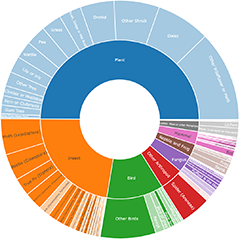Announcements
24 Sep 2025
Hi NatureMapr Data Collector app users,If you experience the following error when attempting to upload sightings from the NatureMapr Data Collector mobile app, please note the following known issue an...
Continue reading
NatureMapr moves to simpler, flatter national structure
Mobile App update and known issues
Discussion
WendyEM
wrote:
20 min ago
An important feature that separates E. excursaria from similar species is that the main dark line running across the hindwing is fairly straight but turns upward as it approaches the edge of the wing, and has a step at the end. This part of the line is not visible in live shots. The forewings need to be further open - which you can sometimes do by gently nudging the wing across with a stick maybe your finger. It depends how flighty the moth is. Another feature is the male's antennae. Your moth could be Ectropis bispinaria in which the male antennae have very short, fine pectinations. (E. excursaria also has fine short pectinations but they are a bit longer) I think I can see very short pectinations on your moth. I am not an anatomist but I think this is a male moth ? Your sightings are very important as you have raised them through so we are trying to get this right.
Ectropis (genus)
DianneClarke
wrote:
29 min ago
Thanks Wendy - have it in a jar so time will tell if I find out which one it is.
Pararguda (genus)
NateKingsford
wrote:
46 min ago
Hey @JenetC, there doesn't seem to be an image attached to this sighting, could you double check this? :)
Missulena occatoria
ibaird
wrote:
47 min ago
Probably is E. excursaria given your other records, but I cannot be sure from yhe photo alone!
Ectropis (genus)
Significant sightings
- Paraselina brunneri at Nightcap, NSW
- Paropsis pantherina at Broke, NSW
- Galadistes pilligaensis at The Pilliga, NSW
- Callocephalon fimbriatum at Aranda, ACT
- Daphnandra micrantha at Pappinbarra, NSW
- Litoria raniformis
- Keyacris scurra at Penrose, NSW
- Callocephalon fimbriatum at Hughes, ACT
- Perunga ochracea at Yarralumla, ACT
- Keyacris scurra at Williamsdale, NSW
Top contributors
- AlisonMilton 17.2K
- trevorpreston 16.2K
- Hejor1 15.1K
- Tapirlord 12.1K
- Mike 10.9K
- MichaelBedingfield 10.8K
- RodDeb 10.5K
- kasiaaus 9.9K
- ConBoekel 9.8K
- KylieWaldon 9.2K
Top moderators
- MichaelMulvaney 61.3K
- Tapirlord 41.7K
- MichaelBedingfield 23.7K
- Liam.m 22.4K
- donhe 18.3K
- natureguy 15.7K
- ibaird 15.5K
- MatthewFrawley 12.3K
- AlisonMilton 11.1K
- plants 9.1K















































































































